三角方程式
三角比,三角関数(教科書範囲) ★★

数学Ⅰ,数学Ⅱ共通ページです.
$\sin \theta=\dfrac{1}{2}$ などの三角方程式の問題を扱います.
数学Ⅰの三角比を勉強中の方は2章までです.
三角方程式とその解き方
三角方程式の解き方
・ $\sin\theta=p$ を解くとき
単位円と $y=p$ の交点の角度を求める.
・ $\cos\theta=q$ を解くとき
単位円と $x=q$ の交点の角度を求める.
・ $\tan\theta=r$ を解くとき
単位円と $y=rx$ の交点の角度を求める.
解き方は上記の通りですが,どの範囲の $\theta$ を求めるかに注意します.例えば $x^{2}=4$ $(x>0)$ などのように条件がある場合,$x=2$ のみに解が絞られるのと同じように,三角方程式を解く上では条件( $\boldsymbol{\theta}$ の範囲)に注意です.
数学Ⅰの三角比では $\theta$ を $0^{\circ}\leqq \theta \leqq 180^{\circ}$ で制限していることが多く,数学Ⅱの三角関数では,弧度法で $0\leqq \theta < 2\pi$ で制限した問題が多いです.制限なしの一般解を問う問題もあります.
例題と練習問題(数学Ⅰ三角比)
例題
例題
$0^{\circ}\leqq \theta \leqq 180^{\circ}$ のとき,次の等式を満たす $\theta$ を求めよ.
(1) $\sin\theta=\dfrac{\sqrt{3}}{2}$
(2) $\sqrt{3}\tan\theta+1=0$
(3) $\sin^{2}\theta+\dfrac{3\sqrt{2}}{2}\cos\theta+1=0$
講義
(1)では $\sin$ は $y$ 座標を表すので,単位円を書いて $y$ 座標が $\dfrac{\sqrt{3}}{2}$ である角度を求めます.
(2)では $\tan$ は傾きを表すので,単位円を書いて $y=-\dfrac{1}{\sqrt{3}}x$ との交点で考えます.
(3)では $\cos$ に統一するために,相互関係 $\color{red}{\cos^{2}\theta+\sin^{2}\theta=1}$ をまず使います.
解答
(1)
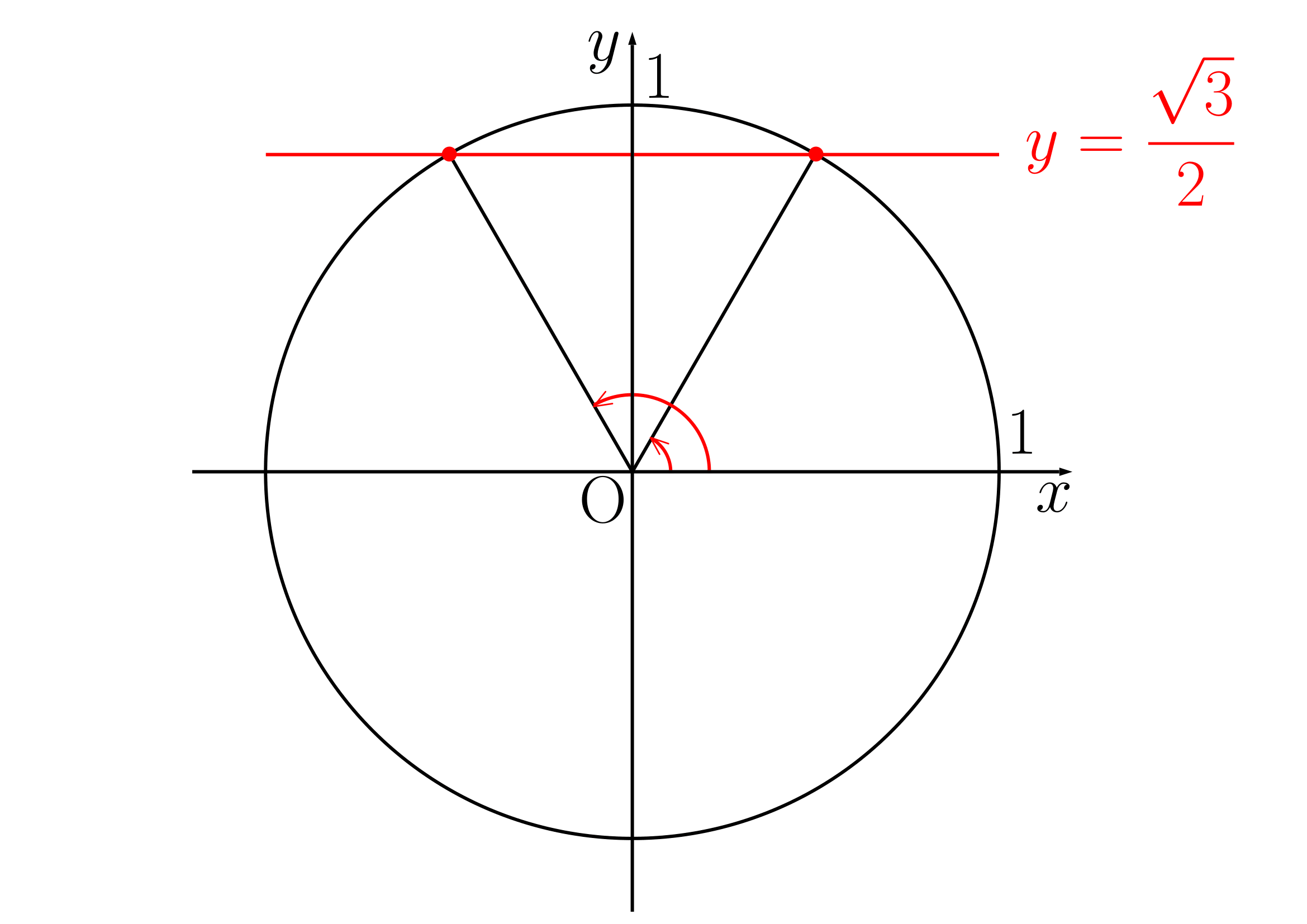
$\boldsymbol{\theta=60^{\circ},120^{\circ}}$
(2)
$\tan\theta=-\dfrac{1}{\sqrt{3}}$ より原点を通る傾きが $-\dfrac{1}{\sqrt{3}}$ の直線を引いて考える.
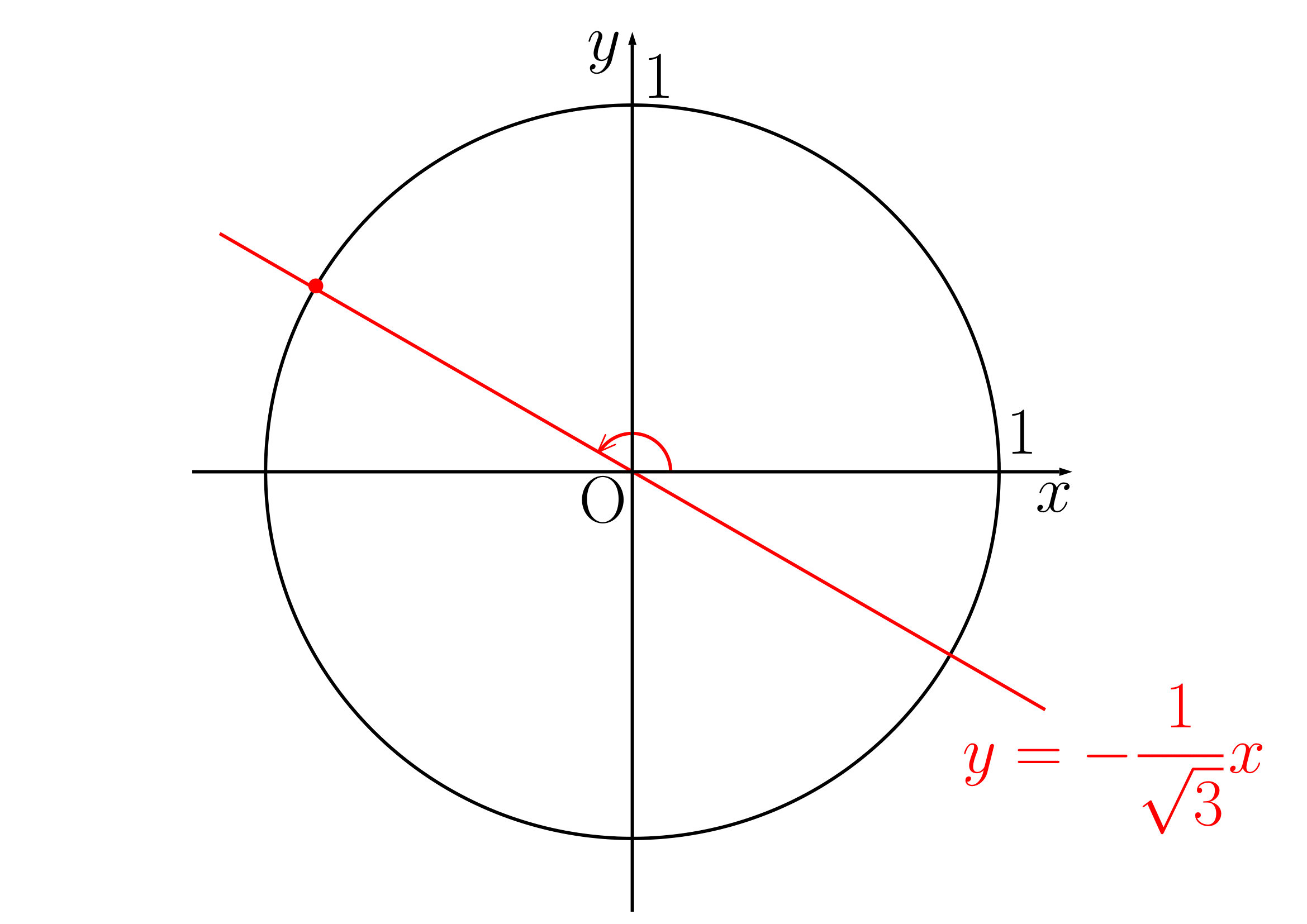
$\boldsymbol{\theta=150^{\circ}}$
(3)
$\sin^{2}\theta+\dfrac{3\sqrt{2}}{2}\cos\theta+1$
$=\color{red}{1-\cos^{2}\theta}+\dfrac{3\sqrt{2}}{2}\cos\theta+1=0$ ←相互関係
$\Longleftrightarrow \ 2\cos^{2}\theta-3\sqrt{2}\cos\theta-4=0$
$\Longleftrightarrow \ (2\cos\theta+\sqrt{2})(\cos\theta-2\sqrt{2})=0$
$\therefore \ \cos\theta=-\dfrac{\sqrt{2}}{2}$ $(\because -1\leqq\cos\theta\leqq 1)$
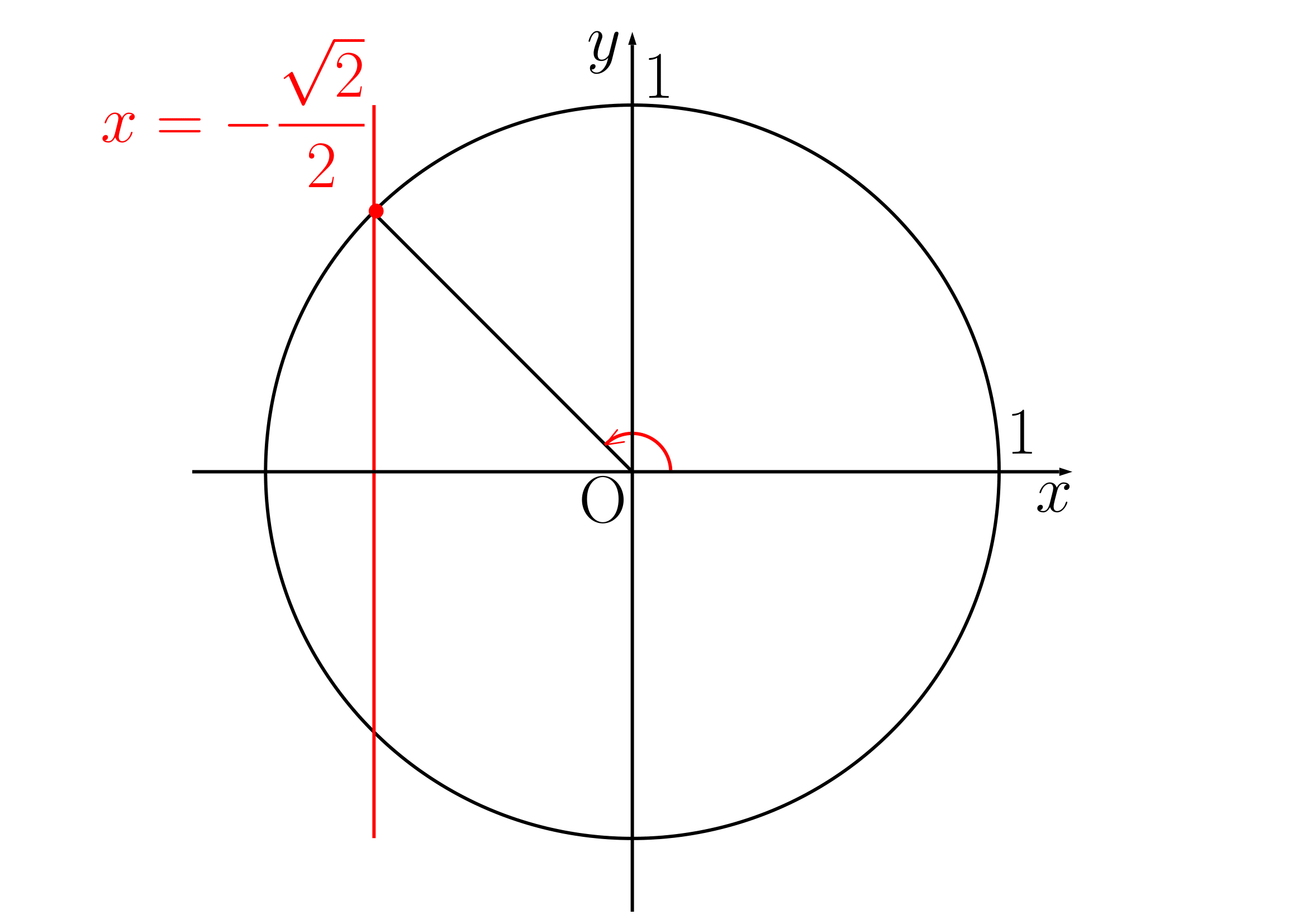
$\therefore \ \boldsymbol{\theta=135^{\circ}}$
練習問題
練習
$0^{\circ}\leqq \theta \leqq 180^{\circ}$ のとき,次の等式を満たす $\theta$ を求めよ.
(1) $\sin\theta=\dfrac{\sqrt{2}}{2}$
(2) $\tan^{2}\theta+\sqrt{3}\tan\theta=0$
(3) $\sqrt{2}\cos^{2}\theta+(1+\sqrt{2})\sin\theta-1-\sqrt{2}=0$
練習の解答
(1)
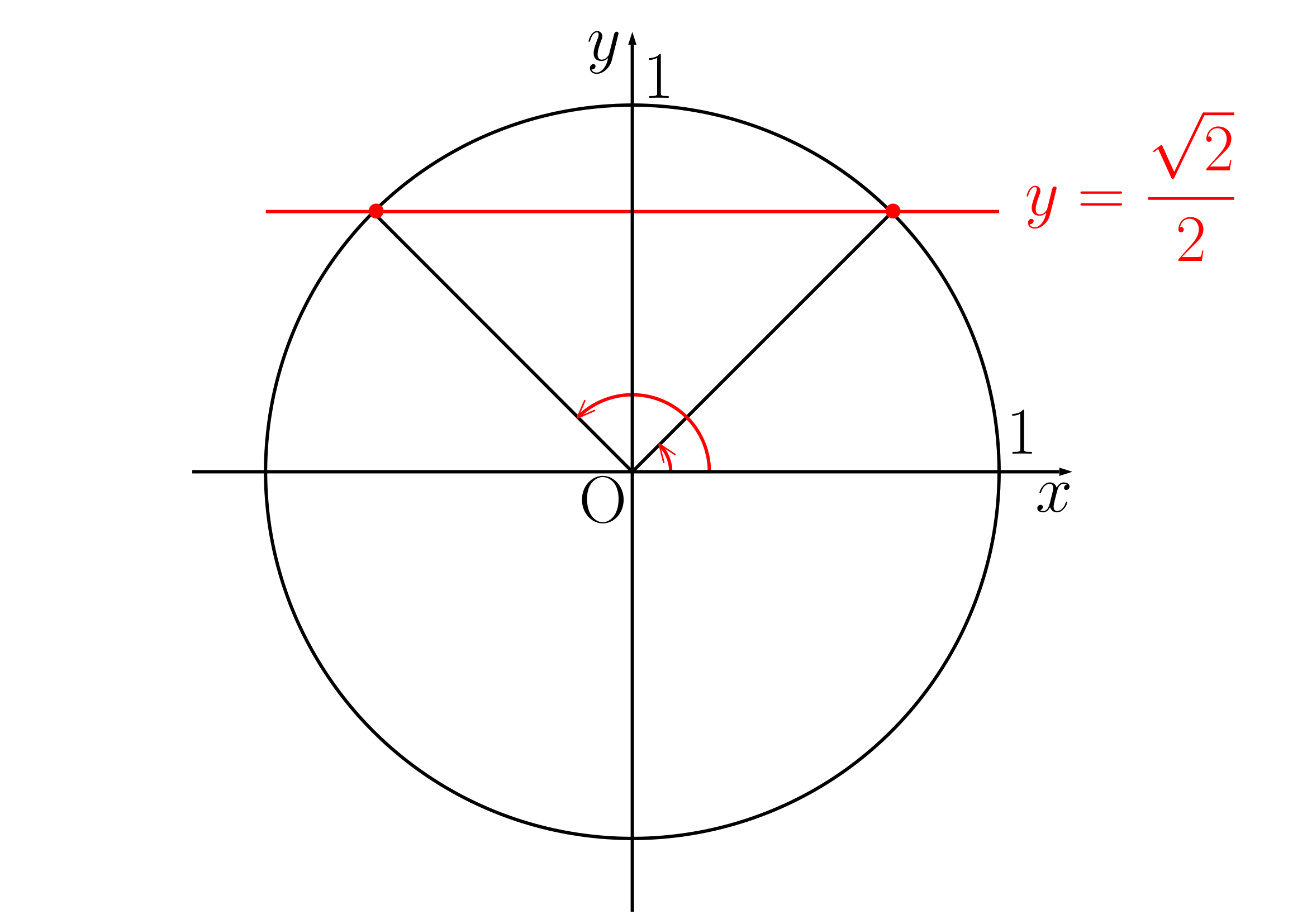
$\boldsymbol{\theta=45^{\circ},135^{\circ}}$
これ以降では練習問題では単位円を割愛します.答案に単位円を書く必要はありませんので.
(2)
$\tan\theta(\tan\theta+\sqrt{3})=0$
$\tan\theta=0,-\sqrt{3}$
$\boldsymbol{\theta=0^{\circ},120^{\circ},180^{\circ}}$
(3)
$\sqrt{2}\cos^{2}\theta+(1+\sqrt{2})\sin\theta-1-\sqrt{2}$
$=\sqrt{2}(1-\sin^{2}\theta)+(1+\sqrt{2})\sin\theta-1-\sqrt{2}$
$=-\sqrt{2}\sin^{2}\theta+(1+\sqrt{2})\sin\theta-1=0$
$\Longleftrightarrow \ \sqrt{2}\sin^{2}\theta-(1+\sqrt{2})\sin\theta+1=0$
$\Longleftrightarrow \ (\sqrt{2}\sin\theta-1)(\sin\theta-1)=0$
$\Longleftrightarrow \ \sin\theta=\dfrac{1}{\sqrt{2}},1$
$\therefore \ \boldsymbol{\theta=45^{\circ},90^{\circ},135^{\circ}}$
例題と練習問題(数学Ⅱ三角関数)
例題
例題
$0\leqq \theta < 2\pi$ のとき,次の等式を満たす $\theta$ を求めよ.また,その一般解も求めよ.
(1) $\sin\theta=\dfrac{\sqrt{3}}{2}$
(2) $\sqrt{3}\tan\theta+1=0$
(3) $\sin^{2}\theta+\dfrac{3\sqrt{2}}{2}\cos\theta+1=0$
(4) $\sin\left(\theta-\dfrac{\pi}{6}\right)=\dfrac{\sqrt{2}}{2}$
(5) $\cos2\theta=\dfrac{\sqrt{2}}{2}$
講義
(3)まで上の数学Ⅰの例題と同じですが,範囲が $0\leqq \theta < 2\pi$ であるのに注意です.
(4)は $X=\theta-\dfrac{\pi}{6}$ と置き換えをして解くとわかりやすいです.
(5)は $2\theta$ の解をまず出しますが,範囲が $0\leqq 2\theta < 4\pi$ (2回転分)であるのに注意です.
一般解は,どれも周期に注目して答えます.
解答
(1)

$\boldsymbol{\theta=\dfrac{\pi}{3},\dfrac{2}{3}\pi}$
また,一般解は $\sin\theta$ の周期は $2\pi$ なので
$\boldsymbol{\theta=\dfrac{\pi}{3}+2k\pi,\dfrac{2}{3}\pi+2k\pi}$ ( $\boldsymbol{k}$ は整数 )
(2)
$\tan\theta=-\dfrac{1}{\sqrt{3}}$ より原点を通る傾きが $-\dfrac{1}{\sqrt{3}}$ の直線を引いて考える.
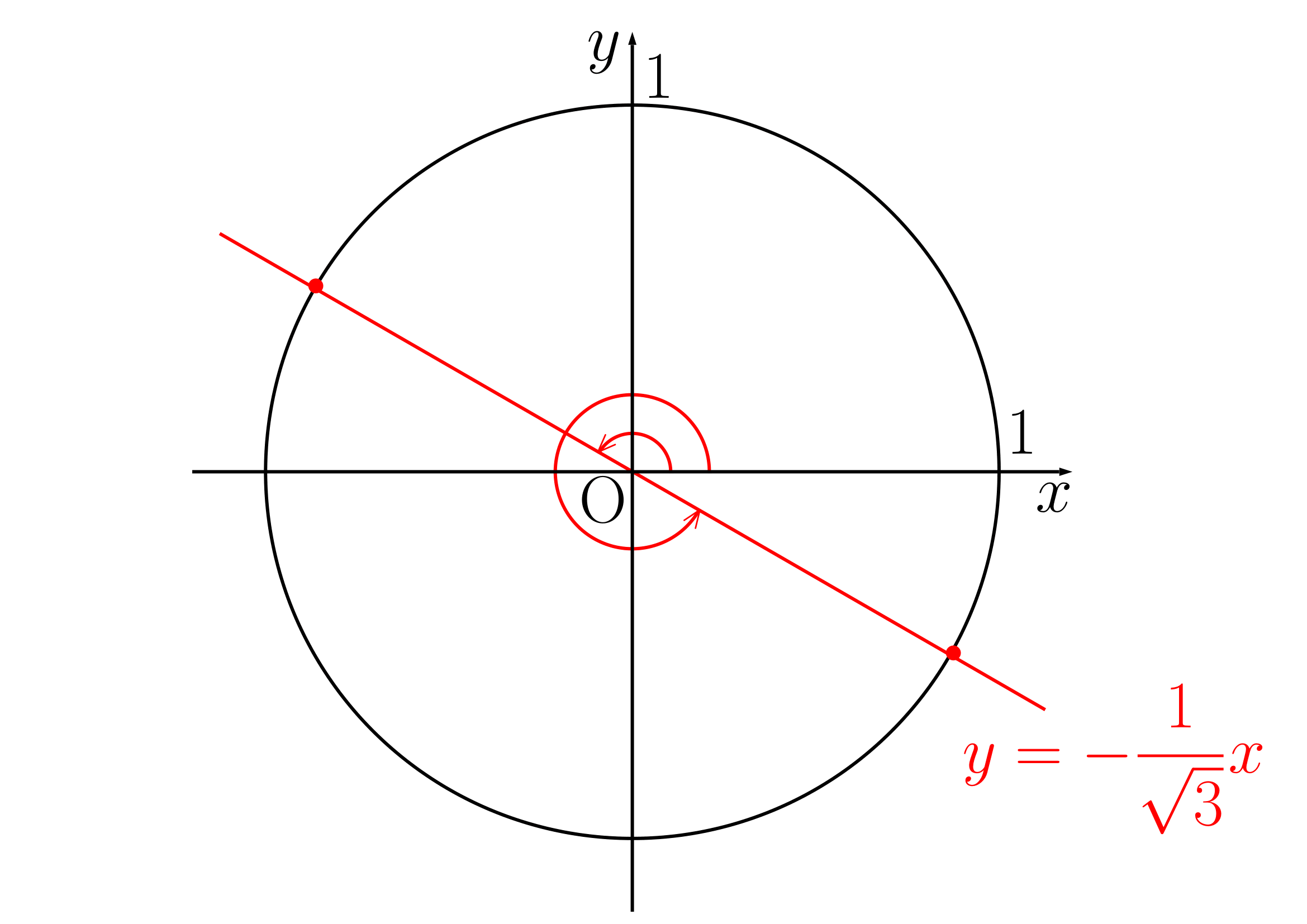
$\boldsymbol{\theta=\dfrac{5}{6}\pi,\dfrac{11}{6}\pi}$
また,一般解は $\tan\theta$ の周期は $\pi$ なので
$\boldsymbol{\theta=\dfrac{5}{6}\pi+k\pi}$ ( $\boldsymbol{k}$ は整数 )
(3)
$\sin^{2}\theta+\dfrac{3\sqrt{2}}{2}\cos\theta+1$
$=\color{red}{1-\cos^{2}\theta}+\dfrac{3\sqrt{2}}{2}\cos\theta+1=0$ ←相互関係
$\Longleftrightarrow \ 2\cos^{2}\theta-3\sqrt{2}\cos\theta-4=0$
$\Longleftrightarrow \ (2\cos\theta+\sqrt{2})(\cos\theta-2\sqrt{2})=0$
$\therefore \ \cos\theta=-\dfrac{\sqrt{2}}{2}$ $(\because -1\leqq\cos\theta\leqq 1)$
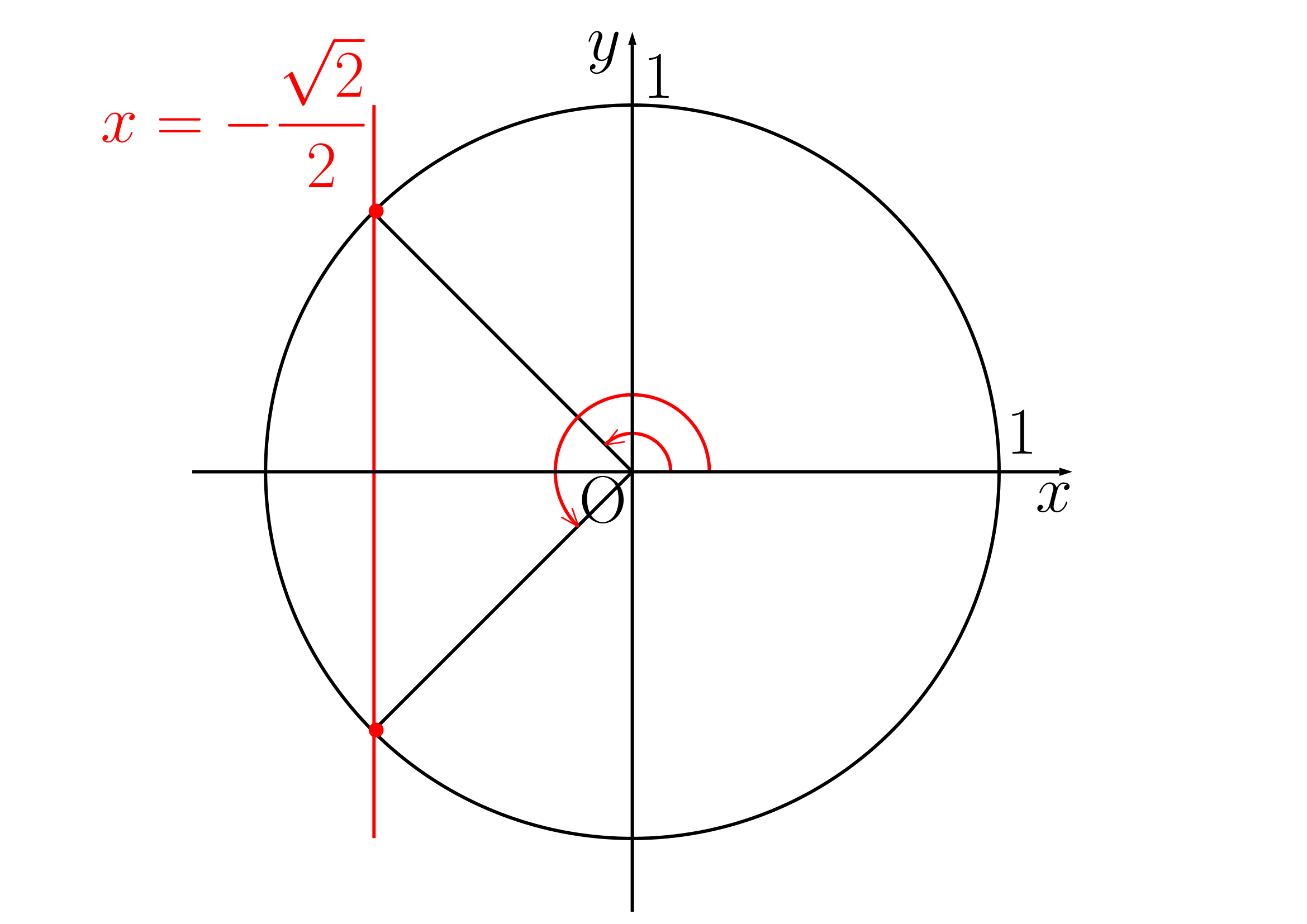
$\therefore \ \boldsymbol{\theta=\dfrac{3}{4}\pi,\dfrac{5}{4}\pi}$
また,一般解は $\cos\theta$ の周期は $2\pi$ なので
$\boldsymbol{\theta=\dfrac{3}{4}\pi+2k\pi,\dfrac{5}{4}\pi+2k\pi}$ ( $\boldsymbol{k}$ は整数 )
(4)
$X=\theta-\dfrac{\pi}{6}$ とおくと
$\sin X=\dfrac{\sqrt{2}}{2}$ $\left(-\dfrac{\pi}{6}\leqq X < \dfrac{11\pi}{6}\right)$

$X=\dfrac{\pi}{4},\dfrac{3}{4}\pi$
$\therefore \ \boldsymbol{\theta=\dfrac{5\pi}{12},\dfrac{11}{12}\pi}$
また,一般解は $\sin\left(\theta-\dfrac{\pi}{6}\right)$ の周期は $2\pi$ なので
$\boldsymbol{\theta=\dfrac{5\pi}{12}+2k\pi,\dfrac{11}{12}\pi+2k\pi}$ ( $\boldsymbol{k}$ は整数 )
(5)
$\cos2\theta=\dfrac{\sqrt{2}}{2}$ $\left(0\leqq 2\theta < 4\pi\right)$
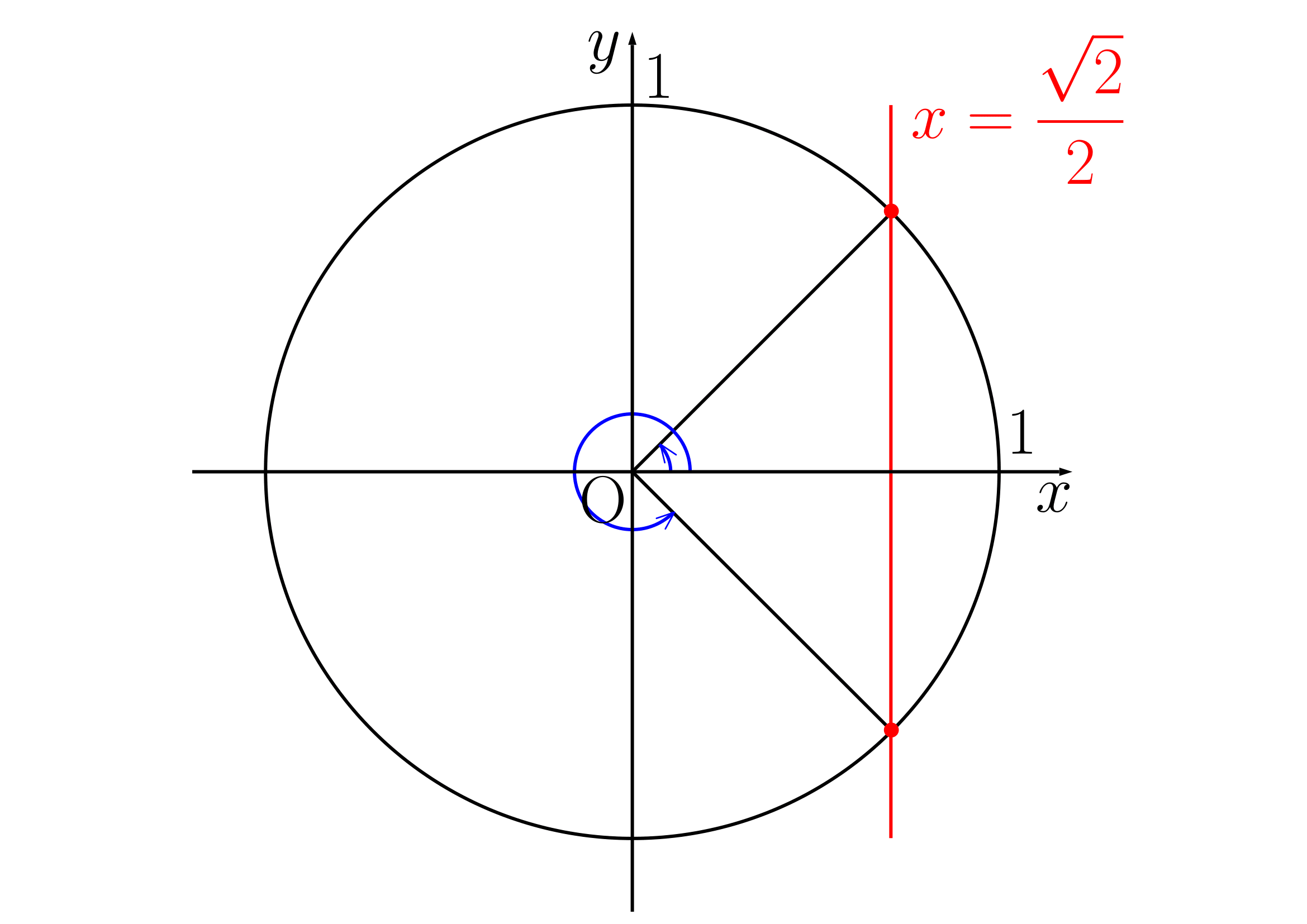
$2\theta=\color{blue}{\dfrac{\pi}{4},\dfrac{7}{4}\pi},\color{green}{\dfrac{9}{4}\pi,\dfrac{15}{4}\pi}$ ($\color{green}{緑}$は2回転目)
$\therefore \ \boldsymbol{\theta=\dfrac{\pi}{8},\dfrac{7}{8}\pi,\dfrac{9}{8}\pi,\dfrac{15}{8}\pi}$
また,一般解は $\cos2\theta$ の周期は $\pi$ なので
$\boldsymbol{\theta=\dfrac{1}{8}\pi+k\pi,\dfrac{7}{8}\pi+k\pi}$ ( $\boldsymbol{k}$ は整数 )
練習問題
練習
$0\leqq \theta < 2\pi$ のとき,次の等式を満たす $\theta$ を求めよ.
(1) $2\sin^{2}\theta+\sqrt{3}\cos\theta-2=0$
(2) $\cos\left(\theta+\dfrac{5}{6}\pi\right)=-\dfrac{1}{2}$
(3) $\tan2\theta=\sqrt{3}$
(4) $\sin\left(2\theta+\dfrac{\pi}{4}\right)=\dfrac{1}{2}$
練習の解答
(1)
$2\sin^{2}\theta+\sqrt{3}\cos\theta-2$
$=2(1-\cos^{2}\theta)+\sqrt{3}\cos\theta-2$
$=-2\cos^{2}\theta+\sqrt{3}\cos\theta=0$
$\Longleftrightarrow \ \cos\theta(2\cos\theta-\sqrt{3})=0$
$\Longleftrightarrow \ \cos\theta=0,\dfrac{\sqrt{3}}{2}$
$\therefore \ \boldsymbol{\theta=\dfrac{\pi}{6},\dfrac{\pi}{2},\dfrac{3}{2}\pi,\dfrac{11}{6}\pi}$
(2)
$X=\theta+\dfrac{5}{6}\pi$ とおくと
$\cos X=-\dfrac{1}{2}$ $\left(\dfrac{5}{6}\pi\leqq X < \dfrac{17}{6}\pi\right)$
$X=\dfrac{4}{3}\pi,\dfrac{8}{3}\pi$
$\therefore \ \boldsymbol{\theta=\dfrac{\pi}{2},\dfrac{11}{6}\pi}$
(3)
$\tan2\theta=\sqrt{3}$ $\left(0\leqq 2\theta < 4\pi\right)$
$2\theta=\dfrac{\pi}{3},\dfrac{4}{3}\pi,\dfrac{7}{3}\pi,\dfrac{10}{3}\pi$
$\therefore \ \boldsymbol{\theta=\dfrac{\pi}{6},\dfrac{2}{3}\pi,\dfrac{7}{6}\pi,\dfrac{5}{3}\pi}$
(4)
$X=2\theta+\dfrac{\pi}{4}$ とおくと
$\sin X=\dfrac{1}{2}$ $\left(\dfrac{\pi}{4}\leqq X < \dfrac{17}{4}\pi\right)$
$X=\dfrac{5}{6}\pi,\dfrac{13}{6}\pi,\dfrac{17}{6}\pi,\dfrac{25}{6}\pi$
$2\theta=\dfrac{7}{12}\pi,\dfrac{23}{12}\pi,\dfrac{31}{12}\pi,\dfrac{47}{12}\pi$
$\therefore \ \boldsymbol{\theta=\dfrac{7}{24}\pi,\dfrac{23}{24}\pi,\dfrac{31}{24}\pi,\dfrac{47}{24}\pi}$
